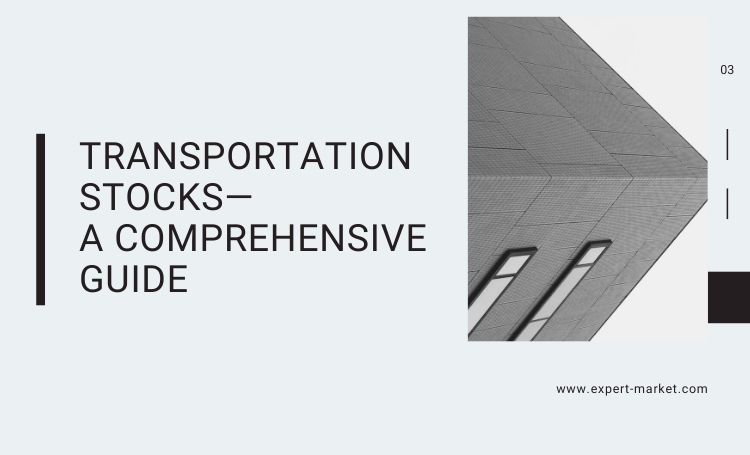The transportation sector has always been one of the prime choices of investors. In the USA it started to get the focus from 1880’s and since around that time so many investors have shown their inclination in this sector.
What are Transportation Stocks?
Transportation stocks are listed under the industrial sector. This sector includes a wide selection of producers of heavy equipment as well as providers of key business services.
We see the following businesses that can be considered branches of the transportation industry:

- Airfreight companies which fly cargo
- Airlines that transport passengers by air
- Trucking companies that transport goods by road
- Railroads that transport passengers and freight by train
- Logistics companies that are involved with the combination of an array of modes of transportation to move things quickly and efficiently
- Marine shipping companies that transport products by sea
- General Transportation Stocks
- There are also some service providers that help other companies with all of the above modes of transportation, such as marine ports, airport operators, and private toll-road companies
Evaluating Transportation Stocks
The operations of such companies in the transportation industry are highly sensitive and relative to fluctuations, depending on the earning of the company and the price of transportation services. Main factors that are affected by transportation company’s earnings include labor costs (that often change in the third worlds and countries with the unstable economy), fuel costs, geopolitical events (such as change of policies from the government and improvement of the roads and highways), demand for services and government regulation.
Here we will be discussing some major factors that one should consider before investing in transportation stocks.
1. Fuel Cost
Companies use a lot of energy to transport passengers, goods, or freights. And the main element that determines the fluctuation in the price of crude oil. Whether they use diesel for trains and trucks, jet fuel for planes, or a combination of electricity and natural gas to run updated (hybrid) vehicles, the cost of fuel is mainly affected by the fluctuation in the price of crude oil, which in turn determines the company’s profit.
2. Debt
It all starts with financing purchases. When the companies execute their purchases through long term debt it appears to be a smart strategy but ultimately it affects negatively when they can’t keep the level down within their sustainability.
3. Economic Strength
When the economy of the country (or within the zone where the company is trading ) is healthy, transportation companies do well because there are plenty of regular transportation options available from a number of small and large scale businesses. The opposite happens when the economy gets weaker. That’s why it is important for an investor to study the economic influence on the sector he is planning to invest in.
4. Competition
In the transportation sector, different companies compete with each other to get in possession of the same customer. In the USA we see that some groups of airlines are fighting against their peers for this reason. You can very well determine which company to choose by observing how full their transporting vehicles are and how much profit they are making.
An article on TaaS stocks from BizReviewed has a clear picture of the transportation as a service and helps an investor decide where to go.
The Most Important Economic Indicators That Impact Transportation Stocks
When you dive into studying the comparison of company-specific metrics you gradually get into the ‘Big Picture’ perspective.
The following indicators are useful to fathom long-term macroeconomic trends. They’re also helpful to identify our current position in the business cycle. Why do we need that? So that we can take advantage of the transport stocks’ best and profitable phase.
1. GDP
Gross domestic product is an aggregate measure of total economic production. Therefore it’s always considered one of the most important and widely followed indicators around the globe.
The GDP report also covers personal consumption along with corporate profits, government purchases, and the foreign trade balance. As a result, we get a lot of information to decide on the overall investment landscape.
We’ll find excellent proof from the graph that showed how the transport index sinks following the deterioration of the GDP line.
2. Interest Rates
When interest rates are low there is a natural boost of consumers and business expenditure which in turn creates an uptrend of demand for shipping goods and freights.
3. Baltic Dry Index
Created by the London-based Baltic Exchange, the BDI Index is an essential indicator for anyone who is trying to assess the state of the global economy. This index shows comprehensive changes to the cost of shipping various commodities, such as fossil fuels, grains, and metals.
Investing in Transportation Stocks
Considering the above features an investor should very well be able to decide when and where he should invest. From a more generalized perspective, this sector is directly related to the economy. The present state and trend of the economy clearly indicate whether or not to invest here.
Post-Covid 19 Situation in Transportation Stocks
Before the start of the COVID 19 crisis, the transportation stocks have shown an elevation trend. Several analyses suggested that transportation stocks were headed higher. Charts like SPDR S&P Transportation ETF (XTN), XPO Logistics, Inc. (XPO), and United Parcel Services, Inc. (UPS) published on 5th August 2019 showed an average uptrend that started during mid-2019.
All had changed after the crisis started. The whole transport sector is having to combat with the unprecedented situation that started with the COVID 19 pandemic. The global lockdown situation set the transportation sector to a sudden standstill. So are transportation stocks.
But things have started to improve. Global Business and economy is trying hard to outsmart the pandemic and get the wheel rolling again. How?
We claim that we are the most adaptive species in the present world. Time has come to prove it. As the traffic on the road has unprecedentedly reduced, so has reduced the traffic congestion, accidents, and fatalities.
Now it’s our chance to futureproof the whole system to be more resilient, flexible, and equitable. In short, planning for some transitional change could very well get us out of the shock and back to a new and more flexible system supporting the mobility of the ever thriving human world.



























